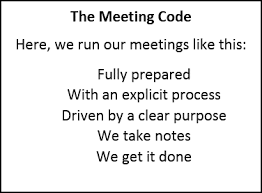 Hopefully, you're taking time at the beach in August and not worrying about attending any meetings.
Hopefully, you're taking time at the beach in August and not worrying about attending any meetings.
My belief is that the whole purpose of August is to cram in as many of your vacation days as possible, since when business ramps up in the post Labor Day Crush you're out in front of it...recharged and ready to sprint toward December's end of the year craziness.
August for me is about reading. Reading about...
- What's new in Sales?
- What's new in Marketing?
- What's new in business strategy?
My goal is a book a day, but it comes out to be more like a book every other day...just because some days aren't beach days, and turn into meeting days.
Good news and bad, as managers, we spend a minimum of 25% of our time in meetings.
- Meetings one-on-one
- Meetings group-on-group
- Meetings to update the staff
- Meetings to rally the troops
- Meetings to plan the future
- Meetings to plan other meetings
 I'm not decrying meetings in general, since, if facilitated correctly and organized around a defined purpose, they can be the most effective means of communicating, of planning and ensuring agreement...especially if there are a few rules of meeting engagement.
I'm not decrying meetings in general, since, if facilitated correctly and organized around a defined purpose, they can be the most effective means of communicating, of planning and ensuring agreement...especially if there are a few rules of meeting engagement.
Here's six seemingly simple rules that often spell the difference between "a disconnected waste of my time" or "an outstanding meeting-can't wait until we meet again"
-
Time, Logistics, Agenda and Follow-Through Notes
These are the simple basics of creating effective meeting management. There should absolutely never be a meeting, no matter how short, without a confirmation of the meeting time, the logistics in terms of address and room number, and a general agenda including a declarative statement on the purpose of the meeting. "When we leave this meeting, we need to have xxxx"
Finally, someone needs to publish the follow-through (not follow-on) action items and agreements coming out of the meeting. Nothing exhaustive. Just an email or a two page PPT, that firmly states the decisions reached and the follow-through action items agreed to along with dates and responsibilities. Should take all of 10 minutes to complete and circulate always asking everyone for edits within 24 hours. -
Chairs, Good Food & Great Service
For those longer meetings, often the emotional success of the meeting will be colored by the comfort of the chairs, the fact that food was available on time, 15 minute breaks scheduled appropriately and the decision, if the meeting were to be offsite, to hold the meeting somewhere "interesting" rather than at the local Holiday Inn.
Having said that, I would give high marks to the Holiday Inn in Dedham, MA for a sales meeting that I just attended there earlier this week. Other great places to consider around the Boston area would be the MIT Endicott House (always my 1st Choice), or the Babson Conference Center. These are places that exist only to focus on servicing corporate meetings...and they both have comfortable chairs. -
The Derby Rules
A couple of simple rules, well known around Boston, that always work very well:
-The last person into the room after the agreed-on time owes everyone else $5.00
.
- No cell phones. If it rings, the payment is $5,00 to everyone in the room. If you use it, other than for emergencies, the payment is also $5,00 to everyone else -
Follow the 8-18-1800 Rule (from a recent HBR blog)
For a meeting to be useful, you have to have the right people – and only the right people – in the room. With too many attendees, you’ll have trouble focusing everyone’s time and attention and accomplishing anything; with too few, you might not have the right decision makers or stakeholders in the room. Before your next meeting, think about the 8-18-1800 rule:
- If you want to solve a problem or make a decision, invite no more than 8 people.
- If you want to brainstorm, you can go up to 18 people.
- If the purpose of the meeting is for you to provide updates, invite however many people need to hear those updates. But if everyone will be giving updates, limit the number of participants to no more than 18.
- If the purpose of the meeting is for you to rally the troops, go for 1,800 – or more.
-
Every Meeting Needs a Purpose (also from a recent HBR Blog)
A simple rule: the more prep you do before a meeting, the more productive it will be. That’s why you must identify a meeting’s purpose (do you need to make a decision, solve a problem, brainstorm or rally the troops), create an agenda, and invite the right people. But there's another important step that many forget: identifying the decision-making process. Choosing a method ahead of time helps ensure that you leave with a clear outcome. Here are some options:
- A majority vote lets every voice be heard, though some people might not be comfortable declaring their opinion publicly.
- Group consensus allows participants to share their expertise and enhances the chance for buy-in from all parties.
- Leader’s choice is usually the fastest approach, so you’d opt for this during appropriate in a crisis, for example. But you may need to work harder to get skeptics on board.
- CHALLENGE YOUR MEETING ATTENDEES
In the world of Sales, we spend around 30% of our time in non-selling group meetings, not including our annual or biannual sales meetings. If you're a member of the senior management team, that number climbs to 38%-42%. The numbers are what they are, and I'm personally not really sure if these numbers are good or bad since I know that some of my most productive time is spent in peer meetings hashing through future plans for the business and for launching new sales tactics.
Having said that, the meeting owner needs to always make sure that they are actually challenging the attendees rather than merely feeding them information and going through the motions of reading boring PowerPoints. What a waste of time and talent, and unfortunately this practice still happens way too much of the time...especially in board meetings. Remember how you hated lecturing professors in college and how excited you became when that professor actually engaged you and the rest of the class into problem solving. Remember that when you're planning your next meeting.
Think about creating a proactive process to actually engage your meeting attendees by using their expertise and passion for the company in solving just one problem, or better yet to talk through just one opportunity. The responsibility of the meeting owner would be to outline that discussion prior to the meeting- Spend 20%-25% of your meetings using the talent in the room to actively think through one strategic question (no more than one) and one or two tactical solutions.
- "Engage" needs to be the operative word for your sales and management meetings, no matter what the purpose-staff meeting or quarterly review meetings
- "Consistency" should be the second critical word. Keep this process or meeting engagement moving ahead consistently until it becomes part of your department's or the company's operating DNA. This process of engagement always works; you just need to bring it to the point of becoming your operating culture of how you run the business or your sales team.
- Spend 20%-25% of your meetings using the talent in the room to actively think through one strategic question (no more than one) and one or two tactical solutions.
As a student and a facilitator of meetings, I know that they can be much better managed and easily made to be much more productive. No rocket science here, just demanding attention to the basics.
Think through the tactics outlined above, get your team together, engage them and share even better ideas with one another...and then move ahead to change your meeting management. Don't inch along in this process. Make exponential change to your management of meetings this fall, and you will quickly evidence markedly better results in terms of follow through. As a leader, part of your job is to shake things up a bit, and there's no better (or easier) way to demonstrate change in style, in culture and in performance through accountability than by making your meeting truly "remarkable"
Good Selling!
Change is good; remarkable change is better.
Have specific sales questions that you want to bounce off me or any of our other coaches, just email me, and we'll set up a time to talk.
Enjoy the Beach!

Derby Management...for 25 years
-Sales & Marketing Productivity Experts
-Business & Strategy Planning Specialists
-Senior Management Coaching
Box 171322, Boston, MA 02117
617-292-7101
Jack's Cell: 617-504-4222

